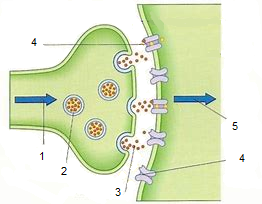The neurotransmitter, often called a chemical messenger, is a molecule used by the nervous system to transmit messages between neurons or from neurons to muscles.
It is released at the end of neurons.
The neurotransmitter is one of the main protagonists of synaptic transmission.
More than fifty have been identified to date.
Communication between two neurons occurs in the synaptic cleft (the small space between the synapses of neurons).
The electrical signals that have traveled along the axon are converted into chemical signals by the release of neurotransmitters, eliciting a specific response in the downstream neuron, due to the neurotransmitter’s interaction with its receptor.
Neuromodulators are a bit different, as they are not limited to the synaptic gap between two neurons and therefore can affect a large number of neurons at once. Neuromotransmitters therefore regulate populations of neurons.
Most neurotransmitters are either small molecules of amines, amino acids, or neuropeptides.
To date, there are a dozen known small molecule neurotransmitters and over 100 different neuropeptides.
These chemicals and their interactions are involved in countless functions of the nervous system as well as in the control of bodily functions.
A neuron and its synaptic termination are identified by the neurotransmitter they produce and release: for example, a cholinergic neuron is a neuron that releases the acetylcholine neurotransmitter at its synapses.
Here are the main neurotransmitters, with their abbreviations and the corresponding qualifier in parentheses:
| Neurotransmitter | Abbreviation | Qualifier |
| Acetylcholine | ACh | cholinergic |
| Dopamine | DA | dopaminergic |
| Noradrenaline | NA | noradrenergic |
| Serotonin | 5-HT | serotonergic |
| Glutamate | Glu | glutamatergic |
| Gamma aminobutyric acid | GABA | gabarergic |
A neurotransmitter influences a neuron in three ways: excitatory, inhibitory, or modulatory.
An excitatory neurotransmitter promotes the generation of an electrical signal called an action potential in the receptor neuron, while an inhibitory neurotransmitter prevents it. Whether a neurotransmitter is excitatory or inhibitory depends on the receptor to which it binds.
Examples of excitatory or inhibitory neurotransmitters
| Neurotransmitter | |
| Acetylcholine | Excitatory |
| Dopamine | Excitatory |
| Noradrenaline | Excitatory |
| Serotonin | Excitatory |
| Glutamate | Excitatory |
| GABA | Inhibitor |
Neurotransmitters perform various functions in the brain when released; here are the main ones:
| Neurotransmitter | Functions |
| Acetylcholine | Promotes attention, memory and learning Stimulates skeletal muscle contraction Dilation of the vessels Contraction of the bronchi, pupil, intestines Bradycardia (heart) Stimulates the excretion of certain hormones |
| Dopamine | Controls motor skills and psoture Coordinates certain cognitive and emotional processes Promotes attention Modulates mood Plays a role in addiction |
| Noradrenaline | Controls vigilance Promotes attention Adjusts certain behaviors such as stress, emotion Acts as a hormone in the blood by stimulating the contraction of blood vessels and increasing the heart rate. |
| Serotonin | Regulates mood Regulates the circadian cycle Pain control Regulates temperature Regulates appetite |
| Glutamate | Promotes long-term learning and memorization of information, plasticity of brain synapses |
| FRONT | Decreases the excitability of neurons It is mainly present in the neurons of the cortex. Contributes to motor control and vision. |
An alteration in their function causes disturbances in the brain, causing disorders – cognitive, psychological and behavioral – depending on the neurotransmitter involved.
Here are some examples of neurotransmitters whose decrease or increase is associated with disorders or diseases.
| Neurotransmitter | Alteration | Disorders and illnesses |
| Acetylcholine | Decrease | Alzheimer’s disease, Parkinson disease |
| Dopamine | Decrease | Parkinson disease |
| Dopamine | Increase | Schizophrenia and other psychotic disorders |
| Noradrenaline | Decrease | Alzheimer’s disease, Depression |
| Serotonin | Decrease | Depression |
| Glutamate | Increase | Stroke, Alzheimer’s disease |
| FRONT | Decrease | Epilepsy |
What happens to neurotransmitters?
The neurotransmitters released by the vesicles will diffuse into the synaptic cleft in which:
- They are degraded by enzymes , proteins that can be compared to scissors cutting in half a neurotransmitter to inactivate it.
- They are re-captured by molecules (called transporters ) located on the membrane of the presynaptic neuron. These transporters ‘pump’ neurotransmitters for reuse. The neuron thus saves the synthesis of neurotransmitter. In general, the greater the release of neurotransmitter, the greater the activity of transporters.
- They bind to proteins (called receptors ) located on the membrane of the presynaptic and postsynaptic neuron.
Receptors located on the membrane of the presynaptic neuron (called presynaptic receptors) control the release, synthesis and reuptake of the neurotransmitter.
The remaining amount of neurotransmitter (that is to say the amount that has not been degraded or recaptured) will bind to receptors located on the membrane of the postsynaptic neuron (we speak of postsynaptic receptor).
Binding of the neurotransmitter with its receptor will lead to a physiological effect (e.g. muscle contraction if the released neurotransmitter is acetylcholine
Where and how are they synthesized ?
They are synthesized by neurons in the nerve ending and / or the cell body. In the latter case, the chemical messenger migrates freely or is transported through the vesicles to the synaptic termination.
This synthesis is done from other molecules (called precursors) called substrates and involves (synthetic) enzymes which accelerate these reactions.
Here is a summary of the fate of a neurotransmitter:

